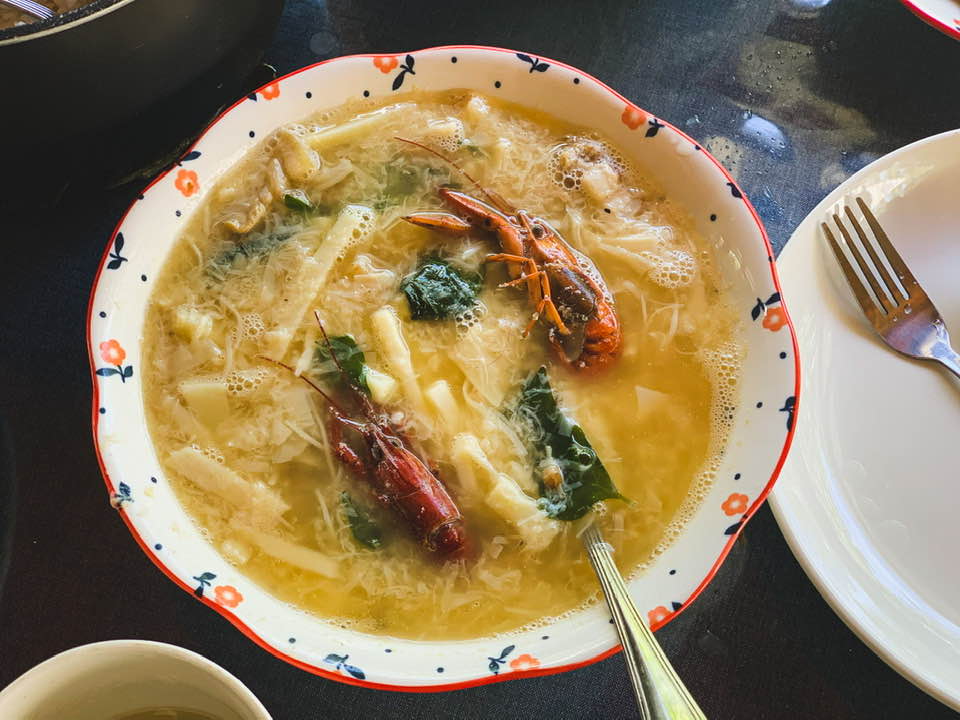
Taste Marinduque: Try Ulang Ulang Ubod Soup with Crayfish for an Explosion of Flavors!

So let me talk about this delicious Filipino soup that originates from my island of Marinduque – Ulang Ulang Soup Ubod Soup. This is a flavorful soup that combines the sweetness of ubod (coconut palm heart) with the sourness of Alugihib, and the unique sweet flavor of Ulang, creating a perfect balance of flavors that will make your taste buds dance.
What is Ulang Ulang
Ulang is freshwater shrimp, used to be abundant in our rivers before Marcopper Mining destroyed our beloved Mogpog river. This specific dish called Ulang Ulang must have been named for it. It is actually a survival food and we only get to taste it after a huge storm and every ingredient comes together. Since we can’t have that, and I am currently taking care of crayfish for breeding in freshwater, I’m using that hehe well…can’t blame me for not trying.
The Ubod (Coconut Palm Heart) and Where To Get It
Meanwhile, my neighbor was cutting down some coconut trees and gave me a portion of the coconut heart, also known as Ubod. This underrated yet absolutely delish ingredient in Filipino cuisine – Ubod a.k.a. coconut palm heart is a delicacy of sorts since we can’t always get it and it’s hard to come by. The tender, nutty-flavored delicacy has been around for centuries and is a must-try for all adventurous eaters out there.
So how do we get this goodness on our plates? First, we gotta go cut down that coconut tree (just kidding, don’t do that!). That’s why I said that this is survival food -we can only get them after a huge storm and coconut trees has fallen down.
There are very rare cases when people are allowed to cut down coconut trees by the PCCA (Philippine Coconut Authority). After cutting down, then the soft, white core is carefully removed from the trunk and sliced thinly to be used in a variety of dishes like salads, soups, and stews. But the most famous dish that uses ubod is actually the iconic Filipino fresh lumpia – a spring roll filled with ubod, carrots, bean sprouts, shrimp, and so much more! In (again) very rare cases, you can find this in town markets. Once I found it at Landmark Mall. If you find one, don’t hesitate to buy it!
Options for Souring the Soup
Typically, people would use Alugihib or bilukaw leaves for sourness. Alugihib, also known as Spondias pinnata, is a type of fruit tree that is native to Southeast Asia, including the Philippines. The tree produces small, yellowish-green fruit that has a tangy and slightly sweet taste. In Filipino cuisine, the fruit is often used as a souring agent in various dishes, particularly in soups and stews. The leaves of the alugihib tree are also used as a seasoning or flavoring in some recipes. But since they weren’t available and my mom’s plants didn’t survive the recent flood, I used calamansi instead. I also added some chili leaves for a pop of green that the leaves provide the dish.
Now, back to the soup. Here’s how you can make Ulang Ulang Ubod Soup with Crayfish:
Ingredients
- 200g of cleaned Crayfish (or other shrimp)
- 1 liter of water
- 1 onion, diced
- 3 cloves of garlic, minced
- 3 cups of ubod (coconut heart), sliced
- 2 pieces of green Alugihib leaves, (or chili leaves if Alugihib is not available)
- 1/4 cup of calamansi juice
- Salt and pepper to taste
Instructions
- Boil the ubod until soft. Drain water and set aside.
- In the same pot, sauté the onion, and garlic until they're fragrant and the onions turn translucent.
- Add the crayfish and saute until red.
- Add the boiled ubod to the pot and stir for a few minutes.
- Pour in the water and bring to a boil. Let it simmer for around 10 minutes.
- Add the Alugihib leaves (if using) and simmer for another 5 minutes.
- Pour in the calamansi juice. Let it simmer for another 5 minutes.
- Add salt and pepper to taste.
Tags
That’s it! Your Ulang Ulang soup with Crayfish is now ready to serve. You can enjoy this soup with a bowl of rice or on its own as a light and healthy meal. Don’t forget to sprinkle some freshly ground black peppers on top for added flavor.
If you’re a fan of seafood and looking for something new to try, give this Ulang Ulang soup with Crayfish a try. It’s a unique dish that highlights the flavors of Marinduque and the Philippines. Plus, it’s a great way to cook coconut heart if you ever happened to get your hands on them and feeling too lazy to make fresh lumpia. So, gather your ingredients and start cooking! And the best part? You’ll be indulging in a time-honored Marinduque delicacy with a rich history and cultural significance. So go ahead, take a bite of the Marinduque!
Ps, don’t forget to use the hashtag #marinduqueeats when you share your delicious creation on social media. Happy cooking!





